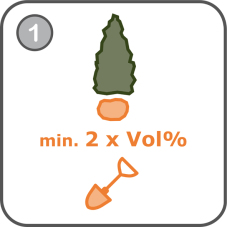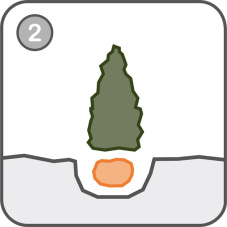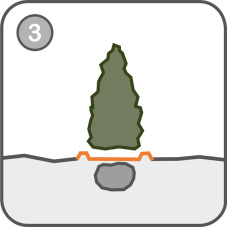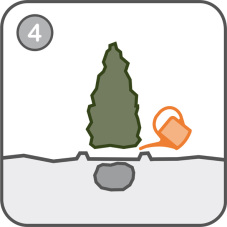
As long as the soil is not frozen, Thuja occidentalis 'Dark Embers'® can be planted. The only exception is waterlogged soil, [caused by snowmelt, heavy rainfall, etc.] in this case the planting must be postponed. Under these circumstances the soil life and texture would suffer severely under the planting works, as well as the plant itself.
As it applies to all garden plants, the empirical formula is that the planting hole should have at least twice the volume of the rootball. When digging the planting hole, you should also loosen up the surrounding soil. This way it is easier for the plant to grow new roots into the ground. Particularly in new development areas and after earthworks a deep loosening of the ground is very important.
Tip! [Hedges]
Hedge plants should be planted with a distance of 15-25 cm. This will ensure that your hedge will grow to an opaque and precious hedge within an adequate period of time. Depending on the size of the plant, this equals 2-3 'Dark Embers'® plants per meter.
The rootball is supposed to be placed right below the soil surface, so that the soil covers the top of the rootball approximately 2-5 cm.
Tip! [Plants from pots]
Eastern Arborvitaes that were grown in a pot should be cut 1 cm deep with a knife into the rootball. This is done best with an equal distance on each of the four sides of the rootball from the top to the bottom and crosswise on the bottom itself. This allows the plant to grow roots more intensely into the new ground.
Once the plant is properly placed in the planting hole, fill up the soil around the rootball and gently recompact it. To ease the initial irrigation, you can form a 3-5 cm high pile of earth around the area of the rootball. This will keep the water in place during the irrigation process.
Tip! [Planting with fertilizers]
In most cases it is not necessary to add fertilizer with the planting. At first, the plant needs to grow roots into the new ground. For very meager soils, fertilizers can be used. We recommend the first fertilization 1-2 months after the planting. In general, fertilizers should be applied only during the period from April to the end of July.
Nevertheless, if you want to add nutrients right away, you can mix slow-release or depot fertilizers with the soil. Suitable for this purpose are organic long-term fertilizers [horn shavings, etc.] or mineral depot fertilizers [compound fertilizers]. Since fertilization is strongly dependent on local and regional conditions, you should also ask your online store or garden center for detailed information about your location/region.
All garden plants must be irrigated after planting in order to join the soil structure with the rootball [just recompacting the soil is not sufficient]. An adequate water supply for freshly planted garden plants is very important. When you irrigate after planting, the water needs to infiltrate the ground till the bottom of the rootball. [See Irrigation]
Tip! [Dry rootballs]
Dry rootballs need to be intensely irrigated or dipped into water [until no air escapes out of the rootball, anymore] before planting.





